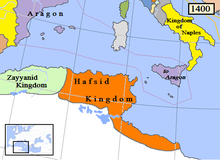Conquest of Tunis (1574)
[7] Selim II sent his support through a messenger, who endeavoured to put the Dutch in contact with the rebellious Moriscos of Spain and the pirates of Algiers.
[8] Selim also sent a great fleet to attack Tunis in the Autumn of 1574, thus succeeding in reducing Spanish pressure on the Dutch.
[11] John of Austria attempted to relieve the siege with a fleet of galleys from Naples and Sicily but failed due to storms.
[3] He wrote about the battle: "If Goleta and the fort, put together, held barely 7,000 soldiers, how could such a small force, however resolute, come out and hold its own against so huge an enemy army.
[6] The success of the Turks under Occhiali[1][14] in the battle of Goleta managed in reducing Spanish pressure on the Dutch, and leading to negotiations at the Conference of Breda.
[8] After the death of Charles IX in May 1574 however, contacts weakened, although the Ottomans are said to have supported the 1575–1576 revolt, and establish, in 1582, a consulate in Antwerp (De Turks-Griekse Natie).



